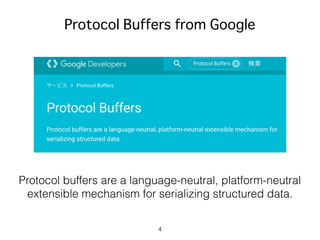Protocol Buffers 入門
- 1. Protocol Buffers 入門 伊藤 裕一 (Yuichi110)
- 2. Agenda ? 分散システムと Protocol Buffers ? Protocol Buffers の簡単な使い方 ? Json などの従来技術との比較 ? Protocol Buffers で RPC を実現する ? Q & A 2
- 3. 自己紹介 ? 伊藤裕一 (twitter: yuichi110) ? - 2016 : Cisco データセンタースイッチ (ネットワーク屋) ? 2016 - : Nutanix ハイパーコンバージド?(サーバー屋) ? 趣味でコード書いたり。。。 3 最近 MyNavi での連載が終了 全36回(2015/05/25 - 2016/02/04)
- 4. 4 Protocol Buffers from Google Protocol buffers are a language-neutral, platform-neutral extensible mechanism for serializing structured data.
- 5. 分散システム ? 複数の「ノード」が連携してシステムとなる ? ノードがダウンしても他のノードが処理を継続 5 Node Node Node Node Distributed System Switch Switch
- 6. 有名な分散システム ? SaaS (Google のサービス系) ? スパコンの対極 6 Cheap Server Cluster
- 7. ノード間の連携 ? クラスタのノード間の通信は TCP/IP ネットワーク経由 ? パケットのペイロードにシステムの情報をのせる 7 Node A Node B Packet Packet mac | ip | tcp | payload (data) 今日はここの話 !!
- 8. Protocol Buffers?で何ができる ? (1) ? データをシリアライズ化するフォーマット ? 入力データをシリアライズ化して圧縮 ? 圧縮されたデータをデシリアライズ(解凍)化して戻す 8 structured data serialized data serialized data structured data Serializer Protocol Buffers De-Serializer Protocol Buffers
- 9. Protocol Buffers?で何ができる ? (2) ? RPC (Remote Procedure Call) のフレームワーク ? 内部的にシリアライズ?デシリアライズを利用 9 Node A Client Node B Server RPC を定義: add(int x, int y) -> int z call : add(1,2) return : 3 calc : 1 + 2 -> 3
- 10. Agenda ? 分散システムと Protocol Buffers ? Protocol Buffers の簡単な使い方 ? Json などの従来技術との比較 ? Protocol Buffers で RPC を実現する ? Q & A 10
- 11. Protocol Buffer を利用する流れ ? プロトコルを定義したファイルを作成 ? ファイルをコンパイルしてコードを生成 ? そのコードを使ってシリアライズ/デシリアライズ/RPC 11
- 12. message Person { required string name = 1; required int32 id = 2; optional string email = 3; enum PhoneType { MOBILE = 0; HOME = 1; WORK = 2; } message PhoneNumber { required string number = 1; optional PhoneType type = 2 [default = HOME]; } repeated PhoneNumber phone = 4; } Language Language structure is similar to Java or C++
- 13. message Person { required string name = 1; required int32 id = 2; optional string email = 3; enum PhoneType { MOBILE = 0; HOME = 1; WORK = 2; } message PhoneNumber { required string number = 1; optional PhoneType type = 2 [default = HOME]; } repeated PhoneNumber phone = 4; } Language message is a small logical record of information
- 14. message Person { required string name = 1; required int32 id = 2; optional string email = 3; repeated PhoneNumber phone = 4; } Language message has numbered ?elds each ?eld has a name and a value type Field Number Field Name Field Value Type numbers (integer or ?oating-point), booleans, strings, raw bytes, etc
- 15. message Person { required string name = 1; required int32 id = 2; optional string email = 3; enum PhoneType { MOBILE = 0; HOME = 1; WORK = 2; } message PhoneNumber { required string number = 1; optional PhoneType type = 2 [default = HOME]; } repeated PhoneNumber phone = 4; } Language can use other protocol buffer message as value type
- 16. message Person { required string name = 1; required int32 id = 2; optional string email = 3; enum PhoneType { MOBILE = 0; HOME = 1; WORK = 2; } message PhoneNumber { required string number = 1; optional PhoneType type = 2 [default = HOME]; } repeated PhoneNumber phone = 4; } Language ?eld type : required, optional, repeated
- 17. Language ? その他多数の機能 ? import ? extend ? service (後述) ? map etc ? 詳細は Language Guide にて 17
- 18. .proto file のコンパイル protoc -I=$SRC_DIR --python_out=$DST_DIR $SRC_DIR/FILE_NAME package tutorial; message Person { required string name = 1; required int32 id = 2; optional string email = 3; enum PhoneType { MOBILE = 0; HOME = 1; WORK = 2; } message PhoneNumber { required string number = 1; optional PhoneType type = 2 [default = HOME]; } repeated PhoneNumber phone = 4; } message AddressBook { repeated Person person = 1; } addressbook.proto (定義) protoc --python_out=./ ./addressbook.proto コンパイル addressbook_pb2.py (コード)
- 19. .proto file のコンパイル ? protoc のオプションで言語を選択 protoc --proto_path=IMPORT_PATH --cpp_out=DST_DIR path/to/?le.proto --java_out=DST_DIR --python_out=DST_DIR 他の言語もコンパイラが存在している
- 20. 生成コードをロードしてみる 20 Python 2.7.10 (default, Oct 23 2015, 19:19:21) [GCC 4.2.1 Compatible Apple LLVM 7.0.0 (clang-700.0.59.5)] on darwin Type "help", "copyright", "credits" or "license" for more information. >>> import addressbook_pb2 >>> dir(addressbook_pb2) ['AddressBook', 'DESCRIPTOR', 'Person', '_ADDRESSBOOK', '_PERSON', '_PERSON_PHONENUMBER', '_PERSON_PHONETYPE', '__builtins__', '__doc__', '__file__', '__name__', '__package__', '_b', '_descriptor', '_message', '_reflection', '_sym_db', '_symbol_database', 'descriptor_pb2', 'sys'] >>> dir(addressbook_pb2.Person) ['ByteSize', 'Clear', 'ClearExtension', 'ClearField', 'CopyFrom', 'DESCRIPTOR', 'EMAIL_FIELD_NUMBER', 'FindInitializationErrors', 'FromString', 'HOME', 'HasExtension', 'HasField', 'ID_FIELD_NUMBER', 'IsInitialized', 'ListFields', 'MOBILE', 'MergeFrom', 'MergeFromString', 'NAME_FIELD_NUMBER', 'PHONE_FIELD_NUMBER', 'ParseFromString', 'PhoneNumber', ‘PhoneType', … ’_decoders_by_tag’, '_extensions_by_name', '_extensions_by_number', '_fields', '_is_present_in_parent', '_listener', '_listener_for_children', '_oneofs', '_unknown_fields', 'email', 'id', 'name', 'phone'] addressbook.proto をコンパイル ファイル名がパッケージに message がクラスに フィールドが変数に
- 21. コードでデータをシリアライズ/デシリアライズ 21 >>> person = addressbook_pb2.Person() >>> person.id = 1234 >>> person.name = "Jon Doe" >>> person.email = “jdoe@example.com" >>> person.SerializeToString() 'nx07Jon Doex10xd2tx1ax10jdoe@example.com’ シリアライズ >>> person2 = addressbook_pb2.Person() >>> person2.ParseFromString("nx07Jon Doex10xd2tx1ax10jdoe@example.com") >>> person2.name u'Jon Doe' デシリアライズ payload にのせてやりとり
- 22. Agenda ? 分散システムと Protocol Buffers ? Protocol Buffers の簡単な使い方 ? Json などの従来技術との比較 ? Protocol Buffers で RPC を実現する ? Q & A 22
- 23. XML/JSON の復習 23 <employees> <employee> <?rstName>John</?rstName> <lastName>Doe</lastName> </employee> <employee> <?rstName>Anna</?rstName> <lastName>Smith</lastName> </employee> <employee> <?rstName>Peter</?rstName> <lastName>Jones</lastName> </employee> </employees> XML Mark up {"employees":[ {"?rstName":"John", "lastName":"Doe"}, {"?rstName":"Anna", "lastName":"Smith"}, {"?rstName":"Peter", "lastName":"Jones"} ]} JSON Key and Value
- 24. XML/JSON を使ったデータの受け渡し 24 Node A Node B Packet XML/JSON writer Structured Data XML/JSON parser Structured Data Object Object socket, REST etc ユーザがオブジェクトとXML/JSONのマッピング
- 25. Protocol buffers を使ったデータの受け渡し Node A Node B Packet serialize (protobuf) Structured Data (protobuf) de-serialize (protobuf) Structured Data (protobuf) Binary Object Object Binary socket, REST etc クラスの利用でオブジェクトのマッピングが不要
- 26. Protobuf が JSON/XML に勝る点 ? reader/writer の処理を自分で書かなくて良い ? 読み書きの処理速度に優れる ? コード変更時のバグが少ない ? データ量が減るため通信が高速化 ? 第三者への難読化 26
- 27. Protobuf が JSON/XML に劣る点 ? protocol buffers のインストールが必要 ? ブラウザなどを通した「外部」からの利用には向いていない ? サービスの「内部」での利用がメイン ? 小さいデータのやりとりには手間がかかりすぎる 27
- 28. Protobuf が JSON/XML と共通 ? データをどう表現するかという「フォーマット」 ? REST などの「コミュニケーション手段」とは別 28
- 29. Agenda ? 分散システムと Protocol Buffers ? Protocol Buffers の簡単な使い方 ? Json などの従来技術との比較 ? Protocol Buffers で RPC を実現する ? Q & A 29
- 30. Nutanix での実利用例 30 仮想化に SAN, ストレージが不要
- 31. Nutanix での実利用例 31 Host A Host B Host C VM1 VM2 VM3 VM4 VM5 VM6 Storage (Hyper Converged) Nutanix Cluster Browser power off vm 6
- 32. Prism Web Server Browser click power off button on vm 6 Prism Web Server Prism Web Server Acropolis VM Management Acropolis VM Management Acropolis VM Management AHV HyperVisor AHV HyperVisor AHV HyperVisor Node A Node B Node C Controller Host Master run the VM6Protobuf rest Nutanix での実利用例
- 33. 33 … 機能 A 汎用 proto 機能 B make class class class … egg ?le 合体 Nutanix での実利用例
- 34. 34 Order 1 Order 2 Order 3 GeneralRPCUtility(protobuf) rest + protobuf From Order 1 Order 2 Order 3 Pythonwebserver To OtherComponentsTheComponent ProtobufServ Acropolis Acropolis Nutanix での実利用例
- 35. RPC の実現 (1) ? .proto file に RPC を定義 ? RPC名(services)、引数(message)、返り値(message) ? クライアント : 生成された RPC の呼び出し ? サーバー : 届けられたデータをデシリアライズし返り値を返す 35 message searchRequest {} message searchResponse {} service searchService { rpc Search (ServiceRequest) returns (SearchResponse); } search.proto
- 36. Node A Node B message A call RPC Structured Data (message A) de-serialize Binary Object Object Binary Structured Data (message A) messageB get RPC result Structured Data (message B) Binary Structured Data (message B) Binary serialize Object implementation Object
- 37. Node A Node B request call RPC Structured Data (message A) de-serialize Binary Object Object Binary Structured Data (message A) response get RPC result Structured Data (message B) Binary Structured Data (message B) Binary serialize Object implementation Object service
- 38. RPCのためのクラス ? RpcController : 継承して細かい挙動の定義 ? RpcChannel : 継承して RPC 通信の方法を実装 ? Service?Class : .proto file から生成されて上記を利用 38 1. Controller, Channel を用意 2. Serviceクラスをインスタンス化 3. 上記インスタンスにRPC引数等を渡す 4. RPCの結果はコールバック等で受け取る 言語により若干の違いあり 詳細は公式ドキュメント等にて
- 39. Agenda ? 分散システムと Protocol Buffers ? Protocol Buffers の簡単な使い方 ? Json などの従来技術との比較 ? Protocol Buffers で RPC を実現する ? Q & A 39
- 40. Thank you !!












![message Person {
required string name = 1;
required int32 id = 2;
optional string email = 3;
enum PhoneType {
MOBILE = 0;
HOME = 1;
WORK = 2;
}
message PhoneNumber {
required string number = 1;
optional PhoneType type = 2 [default = HOME];
}
repeated PhoneNumber phone = 4;
}
Language
Language structure is similar to Java or C++](https://image.slidesharecdn.com/y7bggafnrvowe3klv96q-signature-5ce4433f8af1c17e2ce57af754476f62f68237c9a6c82da6e25fe95fe9079fdd-poli-160427114600/85/Protocol-Buffers-12-320.jpg)
![message Person {
required string name = 1;
required int32 id = 2;
optional string email = 3;
enum PhoneType {
MOBILE = 0;
HOME = 1;
WORK = 2;
}
message PhoneNumber {
required string number = 1;
optional PhoneType type = 2 [default = HOME];
}
repeated PhoneNumber phone = 4;
}
Language
message is a small logical record of information](https://image.slidesharecdn.com/y7bggafnrvowe3klv96q-signature-5ce4433f8af1c17e2ce57af754476f62f68237c9a6c82da6e25fe95fe9079fdd-poli-160427114600/85/Protocol-Buffers-13-320.jpg)

![message Person {
required string name = 1;
required int32 id = 2;
optional string email = 3;
enum PhoneType {
MOBILE = 0;
HOME = 1;
WORK = 2;
}
message PhoneNumber {
required string number = 1;
optional PhoneType type = 2 [default = HOME];
}
repeated PhoneNumber phone = 4;
}
Language
can use other protocol buffer message as value type](https://image.slidesharecdn.com/y7bggafnrvowe3klv96q-signature-5ce4433f8af1c17e2ce57af754476f62f68237c9a6c82da6e25fe95fe9079fdd-poli-160427114600/85/Protocol-Buffers-15-320.jpg)
![message Person {
required string name = 1;
required int32 id = 2;
optional string email = 3;
enum PhoneType {
MOBILE = 0;
HOME = 1;
WORK = 2;
}
message PhoneNumber {
required string number = 1;
optional PhoneType type = 2 [default = HOME];
}
repeated PhoneNumber phone = 4;
}
Language
?eld type : required, optional, repeated](https://image.slidesharecdn.com/y7bggafnrvowe3klv96q-signature-5ce4433f8af1c17e2ce57af754476f62f68237c9a6c82da6e25fe95fe9079fdd-poli-160427114600/85/Protocol-Buffers-16-320.jpg)

![.proto file のコンパイル
protoc -I=$SRC_DIR --python_out=$DST_DIR $SRC_DIR/FILE_NAME
package tutorial;
message Person {
required string name = 1;
required int32 id = 2;
optional string email = 3;
enum PhoneType {
MOBILE = 0;
HOME = 1;
WORK = 2;
}
message PhoneNumber {
required string number = 1;
optional PhoneType type = 2 [default = HOME];
}
repeated PhoneNumber phone = 4;
}
message AddressBook {
repeated Person person = 1;
}
addressbook.proto (定義)
protoc --python_out=./ ./addressbook.proto
コンパイル
addressbook_pb2.py (コード)](https://image.slidesharecdn.com/y7bggafnrvowe3klv96q-signature-5ce4433f8af1c17e2ce57af754476f62f68237c9a6c82da6e25fe95fe9079fdd-poli-160427114600/85/Protocol-Buffers-18-320.jpg)

![生成コードをロードしてみる
20
Python 2.7.10 (default, Oct 23 2015, 19:19:21)
[GCC 4.2.1 Compatible Apple LLVM 7.0.0 (clang-700.0.59.5)] on darwin
Type "help", "copyright", "credits" or "license" for more information.
>>> import addressbook_pb2
>>> dir(addressbook_pb2)
['AddressBook', 'DESCRIPTOR', 'Person', '_ADDRESSBOOK', '_PERSON',
'_PERSON_PHONENUMBER', '_PERSON_PHONETYPE', '__builtins__', '__doc__',
'__file__', '__name__', '__package__', '_b', '_descriptor', '_message',
'_reflection', '_sym_db', '_symbol_database', 'descriptor_pb2', 'sys']
>>> dir(addressbook_pb2.Person)
['ByteSize', 'Clear', 'ClearExtension', 'ClearField', 'CopyFrom', 'DESCRIPTOR',
'EMAIL_FIELD_NUMBER', 'FindInitializationErrors', 'FromString', 'HOME',
'HasExtension', 'HasField', 'ID_FIELD_NUMBER', 'IsInitialized', 'ListFields',
'MOBILE', 'MergeFrom', 'MergeFromString', 'NAME_FIELD_NUMBER',
'PHONE_FIELD_NUMBER', 'ParseFromString', 'PhoneNumber', ‘PhoneType',
…
’_decoders_by_tag’, '_extensions_by_name', '_extensions_by_number', '_fields',
'_is_present_in_parent', '_listener', '_listener_for_children', '_oneofs',
'_unknown_fields', 'email', 'id', 'name', 'phone']
addressbook.proto をコンパイル
ファイル名がパッケージに
message がクラスに
フィールドが変数に](https://image.slidesharecdn.com/y7bggafnrvowe3klv96q-signature-5ce4433f8af1c17e2ce57af754476f62f68237c9a6c82da6e25fe95fe9079fdd-poli-160427114600/85/Protocol-Buffers-20-320.jpg)


![XML/JSON の復習
23
<employees>
<employee>
<?rstName>John</?rstName> <lastName>Doe</lastName>
</employee>
<employee>
<?rstName>Anna</?rstName> <lastName>Smith</lastName>
</employee>
<employee>
<?rstName>Peter</?rstName> <lastName>Jones</lastName>
</employee>
</employees>
XML
Mark up
{"employees":[
{"?rstName":"John", "lastName":"Doe"},
{"?rstName":"Anna", "lastName":"Smith"},
{"?rstName":"Peter", "lastName":"Jones"}
]}
JSON
Key and Value](https://image.slidesharecdn.com/y7bggafnrvowe3klv96q-signature-5ce4433f8af1c17e2ce57af754476f62f68237c9a6c82da6e25fe95fe9079fdd-poli-160427114600/85/Protocol-Buffers-23-320.jpg)
















